Analysis of Medication Use in Social Care: Policies and Practices
VerifiedAdded on 2020/06/04
|9
|2137
|55
Report
AI Summary
This report provides a detailed analysis of medication use within social care settings, focusing on the responsibilities of practitioners and the legal frameworks governing medication management, primarily within the NHS context. The report begins by examining relevant legislation, including the Medicines Act 1968, the Health Act 2006, and the Misuse of Drugs Act 2001, highlighting their impact on the safe handling of medications. It then outlines the roles and responsibilities of various individuals involved in medication use, such as care workers, registered managers, nurses, and pharmacists. The report describes how information on individual medication is accessed through Medication Administration Record sheets (MAR), care plans, and medical records. It further explains the different routes of medicine administration, including ingestion, inhalation, injection, and infusion, and recognizes various forms of medication presentation such as solids, liquids, and gases. Techniques such as spacer devices, oral syringes, and nebulizers are discussed as aids in medication management. The report also details the data that should be recorded for individual medication use, emphasizing the importance of MAR sheets, care records, and controlled drug books. Additionally, it covers the safe storage of various medications, including COSHH and heat regulation, and provides guidance on the secure disposal of unused or unwanted medications, referencing hazardous waste regulations and local guidelines. The conclusion emphasizes the significance of these practices for ensuring patient safety and effective healthcare delivery in social care settings.
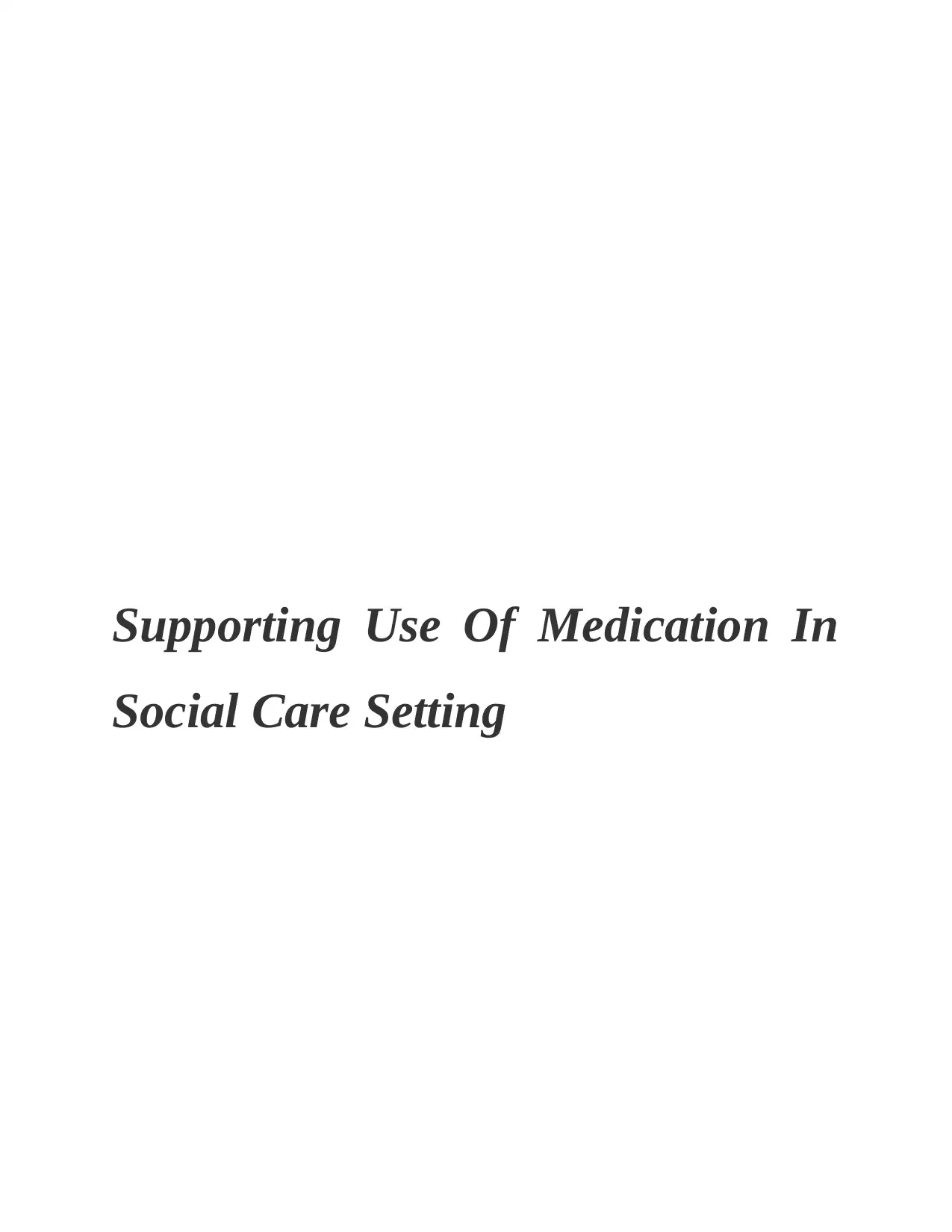
Supporting Use Of Medication In
Social Care Setting
Social Care Setting
Paraphrase This Document
Need a fresh take? Get an instant paraphrase of this document with our AI Paraphraser
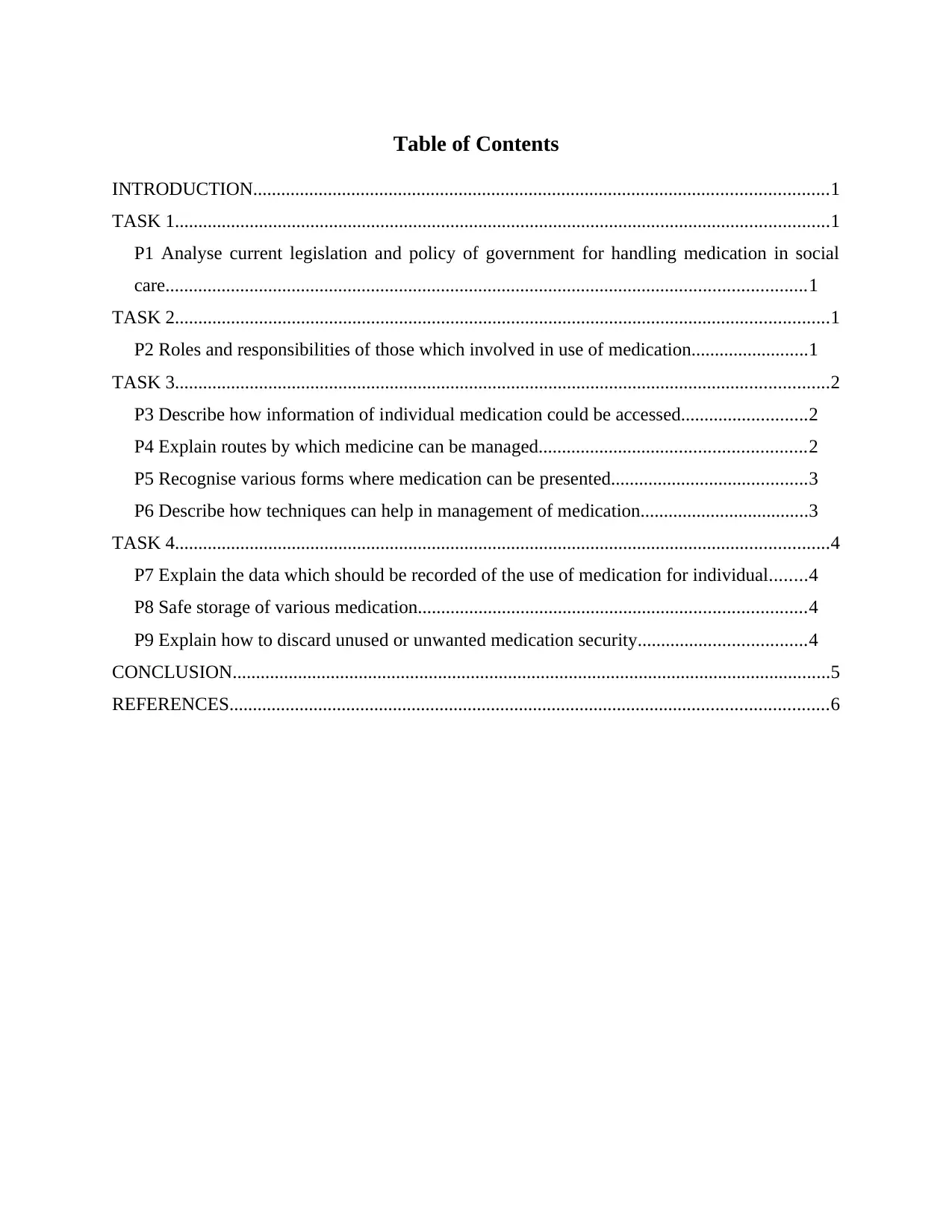
Table of Contents
INTRODUCTION...........................................................................................................................1
TASK 1............................................................................................................................................1
P1 Analyse current legislation and policy of government for handling medication in social
care.........................................................................................................................................1
TASK 2............................................................................................................................................1
P2 Roles and responsibilities of those which involved in use of medication.........................1
TASK 3............................................................................................................................................2
P3 Describe how information of individual medication could be accessed...........................2
P4 Explain routes by which medicine can be managed.........................................................2
P5 Recognise various forms where medication can be presented..........................................3
P6 Describe how techniques can help in management of medication....................................3
TASK 4............................................................................................................................................4
P7 Explain the data which should be recorded of the use of medication for individual........4
P8 Safe storage of various medication...................................................................................4
P9 Explain how to discard unused or unwanted medication security....................................4
CONCLUSION................................................................................................................................5
REFERENCES................................................................................................................................6
INTRODUCTION...........................................................................................................................1
TASK 1............................................................................................................................................1
P1 Analyse current legislation and policy of government for handling medication in social
care.........................................................................................................................................1
TASK 2............................................................................................................................................1
P2 Roles and responsibilities of those which involved in use of medication.........................1
TASK 3............................................................................................................................................2
P3 Describe how information of individual medication could be accessed...........................2
P4 Explain routes by which medicine can be managed.........................................................2
P5 Recognise various forms where medication can be presented..........................................3
P6 Describe how techniques can help in management of medication....................................3
TASK 4............................................................................................................................................4
P7 Explain the data which should be recorded of the use of medication for individual........4
P8 Safe storage of various medication...................................................................................4
P9 Explain how to discard unused or unwanted medication security....................................4
CONCLUSION................................................................................................................................5
REFERENCES................................................................................................................................6

⊘ This is a preview!⊘
Do you want full access?
Subscribe today to unlock all pages.

Trusted by 1+ million students worldwide
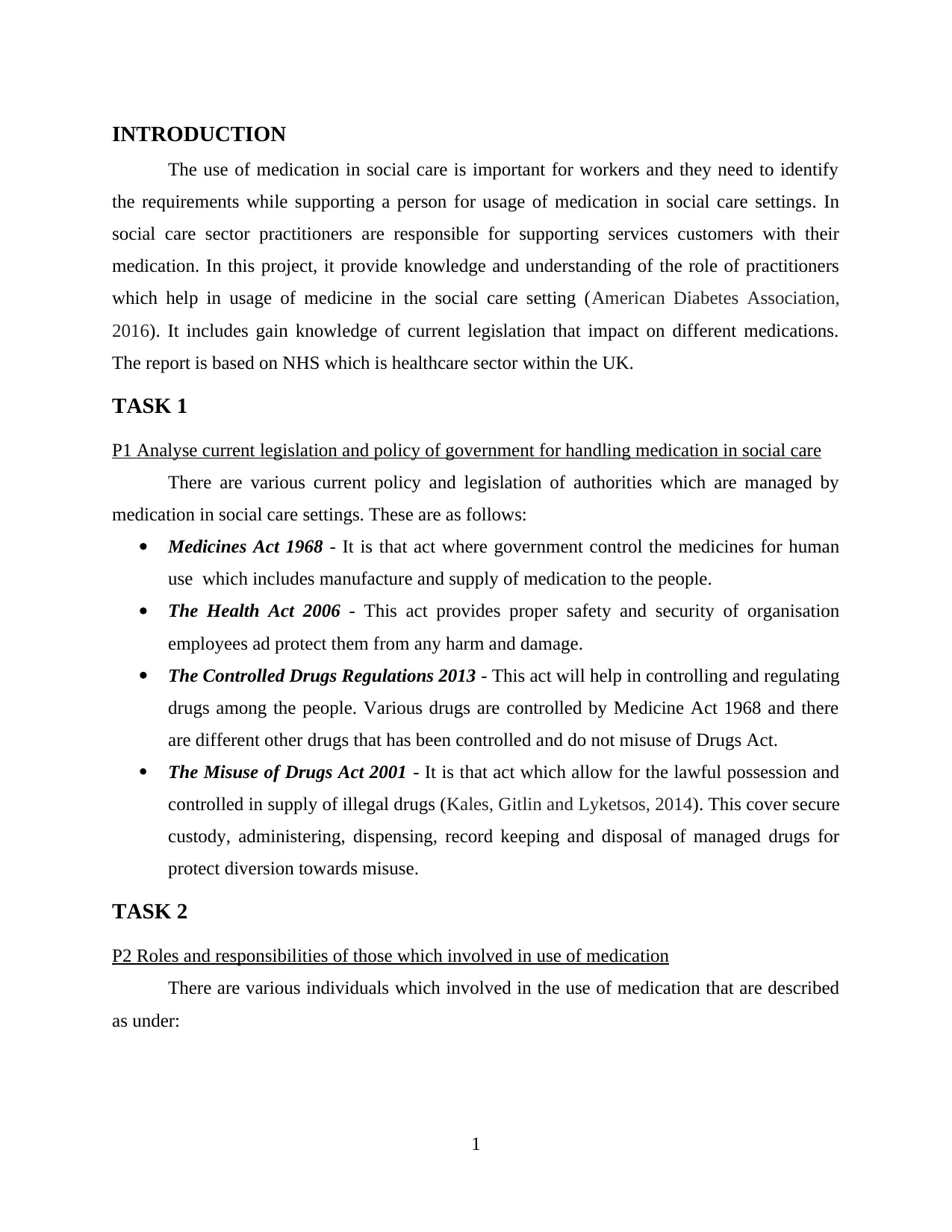
INTRODUCTION
The use of medication in social care is important for workers and they need to identify
the requirements while supporting a person for usage of medication in social care settings. In
social care sector practitioners are responsible for supporting services customers with their
medication. In this project, it provide knowledge and understanding of the role of practitioners
which help in usage of medicine in the social care setting (American Diabetes Association,
2016). It includes gain knowledge of current legislation that impact on different medications.
The report is based on NHS which is healthcare sector within the UK.
TASK 1
P1 Analyse current legislation and policy of government for handling medication in social care
There are various current policy and legislation of authorities which are managed by
medication in social care settings. These are as follows:
Medicines Act 1968 - It is that act where government control the medicines for human
use which includes manufacture and supply of medication to the people.
The Health Act 2006 - This act provides proper safety and security of organisation
employees ad protect them from any harm and damage.
The Controlled Drugs Regulations 2013 - This act will help in controlling and regulating
drugs among the people. Various drugs are controlled by Medicine Act 1968 and there
are different other drugs that has been controlled and do not misuse of Drugs Act.
The Misuse of Drugs Act 2001 - It is that act which allow for the lawful possession and
controlled in supply of illegal drugs (Kales, Gitlin and Lyketsos, 2014). This cover secure
custody, administering, dispensing, record keeping and disposal of managed drugs for
protect diversion towards misuse.
TASK 2
P2 Roles and responsibilities of those which involved in use of medication
There are various individuals which involved in the use of medication that are described
as under:
1
The use of medication in social care is important for workers and they need to identify
the requirements while supporting a person for usage of medication in social care settings. In
social care sector practitioners are responsible for supporting services customers with their
medication. In this project, it provide knowledge and understanding of the role of practitioners
which help in usage of medicine in the social care setting (American Diabetes Association,
2016). It includes gain knowledge of current legislation that impact on different medications.
The report is based on NHS which is healthcare sector within the UK.
TASK 1
P1 Analyse current legislation and policy of government for handling medication in social care
There are various current policy and legislation of authorities which are managed by
medication in social care settings. These are as follows:
Medicines Act 1968 - It is that act where government control the medicines for human
use which includes manufacture and supply of medication to the people.
The Health Act 2006 - This act provides proper safety and security of organisation
employees ad protect them from any harm and damage.
The Controlled Drugs Regulations 2013 - This act will help in controlling and regulating
drugs among the people. Various drugs are controlled by Medicine Act 1968 and there
are different other drugs that has been controlled and do not misuse of Drugs Act.
The Misuse of Drugs Act 2001 - It is that act which allow for the lawful possession and
controlled in supply of illegal drugs (Kales, Gitlin and Lyketsos, 2014). This cover secure
custody, administering, dispensing, record keeping and disposal of managed drugs for
protect diversion towards misuse.
TASK 2
P2 Roles and responsibilities of those which involved in use of medication
There are various individuals which involved in the use of medication that are described
as under:
1
Paraphrase This Document
Need a fresh take? Get an instant paraphrase of this document with our AI Paraphraser
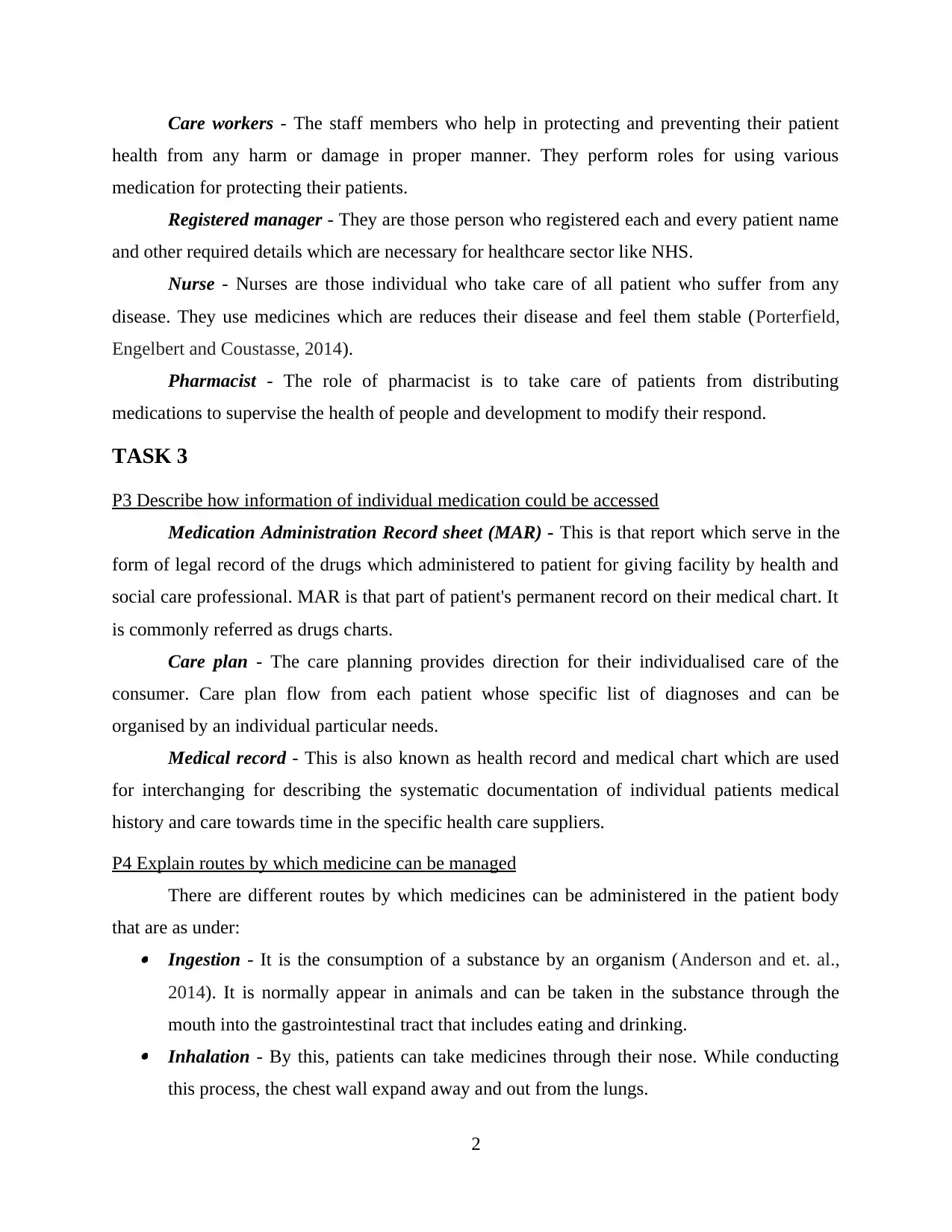
Care workers - The staff members who help in protecting and preventing their patient
health from any harm or damage in proper manner. They perform roles for using various
medication for protecting their patients.
Registered manager - They are those person who registered each and every patient name
and other required details which are necessary for healthcare sector like NHS.
Nurse - Nurses are those individual who take care of all patient who suffer from any
disease. They use medicines which are reduces their disease and feel them stable (Porterfield,
Engelbert and Coustasse, 2014).
Pharmacist - The role of pharmacist is to take care of patients from distributing
medications to supervise the health of people and development to modify their respond.
TASK 3
P3 Describe how information of individual medication could be accessed
Medication Administration Record sheet (MAR) - This is that report which serve in the
form of legal record of the drugs which administered to patient for giving facility by health and
social care professional. MAR is that part of patient's permanent record on their medical chart. It
is commonly referred as drugs charts.
Care plan - The care planning provides direction for their individualised care of the
consumer. Care plan flow from each patient whose specific list of diagnoses and can be
organised by an individual particular needs.
Medical record - This is also known as health record and medical chart which are used
for interchanging for describing the systematic documentation of individual patients medical
history and care towards time in the specific health care suppliers.
P4 Explain routes by which medicine can be managed
There are different routes by which medicines can be administered in the patient body
that are as under: Ingestion - It is the consumption of a substance by an organism (Anderson and et. al.,
2014). It is normally appear in animals and can be taken in the substance through the
mouth into the gastrointestinal tract that includes eating and drinking. Inhalation - By this, patients can take medicines through their nose. While conducting
this process, the chest wall expand away and out from the lungs.
2
health from any harm or damage in proper manner. They perform roles for using various
medication for protecting their patients.
Registered manager - They are those person who registered each and every patient name
and other required details which are necessary for healthcare sector like NHS.
Nurse - Nurses are those individual who take care of all patient who suffer from any
disease. They use medicines which are reduces their disease and feel them stable (Porterfield,
Engelbert and Coustasse, 2014).
Pharmacist - The role of pharmacist is to take care of patients from distributing
medications to supervise the health of people and development to modify their respond.
TASK 3
P3 Describe how information of individual medication could be accessed
Medication Administration Record sheet (MAR) - This is that report which serve in the
form of legal record of the drugs which administered to patient for giving facility by health and
social care professional. MAR is that part of patient's permanent record on their medical chart. It
is commonly referred as drugs charts.
Care plan - The care planning provides direction for their individualised care of the
consumer. Care plan flow from each patient whose specific list of diagnoses and can be
organised by an individual particular needs.
Medical record - This is also known as health record and medical chart which are used
for interchanging for describing the systematic documentation of individual patients medical
history and care towards time in the specific health care suppliers.
P4 Explain routes by which medicine can be managed
There are different routes by which medicines can be administered in the patient body
that are as under: Ingestion - It is the consumption of a substance by an organism (Anderson and et. al.,
2014). It is normally appear in animals and can be taken in the substance through the
mouth into the gastrointestinal tract that includes eating and drinking. Inhalation - By this, patients can take medicines through their nose. While conducting
this process, the chest wall expand away and out from the lungs.
2
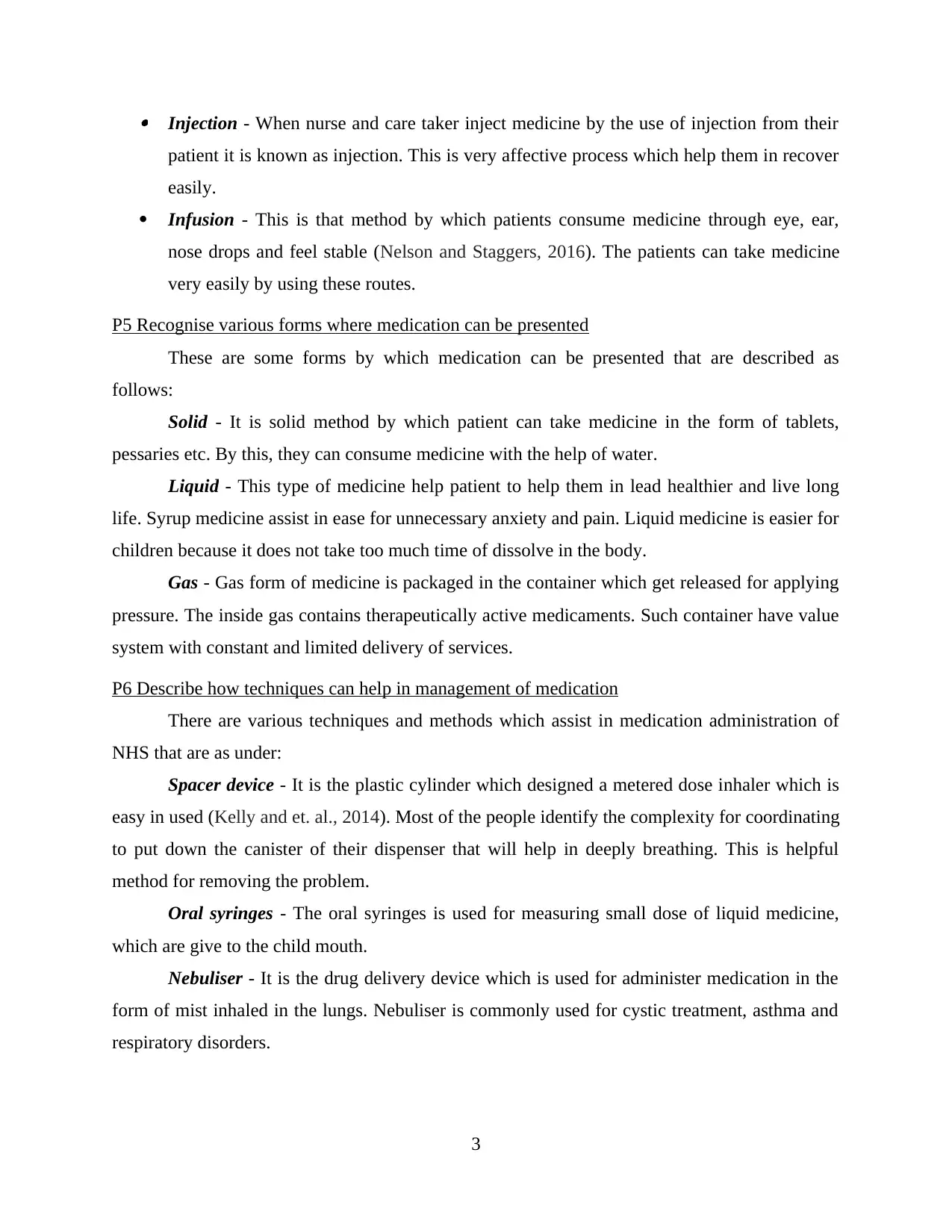
Injection - When nurse and care taker inject medicine by the use of injection from their
patient it is known as injection. This is very affective process which help them in recover
easily.
Infusion - This is that method by which patients consume medicine through eye, ear,
nose drops and feel stable (Nelson and Staggers, 2016). The patients can take medicine
very easily by using these routes.
P5 Recognise various forms where medication can be presented
These are some forms by which medication can be presented that are described as
follows:
Solid - It is solid method by which patient can take medicine in the form of tablets,
pessaries etc. By this, they can consume medicine with the help of water.
Liquid - This type of medicine help patient to help them in lead healthier and live long
life. Syrup medicine assist in ease for unnecessary anxiety and pain. Liquid medicine is easier for
children because it does not take too much time of dissolve in the body.
Gas - Gas form of medicine is packaged in the container which get released for applying
pressure. The inside gas contains therapeutically active medicaments. Such container have value
system with constant and limited delivery of services.
P6 Describe how techniques can help in management of medication
There are various techniques and methods which assist in medication administration of
NHS that are as under:
Spacer device - It is the plastic cylinder which designed a metered dose inhaler which is
easy in used (Kelly and et. al., 2014). Most of the people identify the complexity for coordinating
to put down the canister of their dispenser that will help in deeply breathing. This is helpful
method for removing the problem.
Oral syringes - The oral syringes is used for measuring small dose of liquid medicine,
which are give to the child mouth.
Nebuliser - It is the drug delivery device which is used for administer medication in the
form of mist inhaled in the lungs. Nebuliser is commonly used for cystic treatment, asthma and
respiratory disorders.
3
patient it is known as injection. This is very affective process which help them in recover
easily.
Infusion - This is that method by which patients consume medicine through eye, ear,
nose drops and feel stable (Nelson and Staggers, 2016). The patients can take medicine
very easily by using these routes.
P5 Recognise various forms where medication can be presented
These are some forms by which medication can be presented that are described as
follows:
Solid - It is solid method by which patient can take medicine in the form of tablets,
pessaries etc. By this, they can consume medicine with the help of water.
Liquid - This type of medicine help patient to help them in lead healthier and live long
life. Syrup medicine assist in ease for unnecessary anxiety and pain. Liquid medicine is easier for
children because it does not take too much time of dissolve in the body.
Gas - Gas form of medicine is packaged in the container which get released for applying
pressure. The inside gas contains therapeutically active medicaments. Such container have value
system with constant and limited delivery of services.
P6 Describe how techniques can help in management of medication
There are various techniques and methods which assist in medication administration of
NHS that are as under:
Spacer device - It is the plastic cylinder which designed a metered dose inhaler which is
easy in used (Kelly and et. al., 2014). Most of the people identify the complexity for coordinating
to put down the canister of their dispenser that will help in deeply breathing. This is helpful
method for removing the problem.
Oral syringes - The oral syringes is used for measuring small dose of liquid medicine,
which are give to the child mouth.
Nebuliser - It is the drug delivery device which is used for administer medication in the
form of mist inhaled in the lungs. Nebuliser is commonly used for cystic treatment, asthma and
respiratory disorders.
3
⊘ This is a preview!⊘
Do you want full access?
Subscribe today to unlock all pages.

Trusted by 1+ million students worldwide
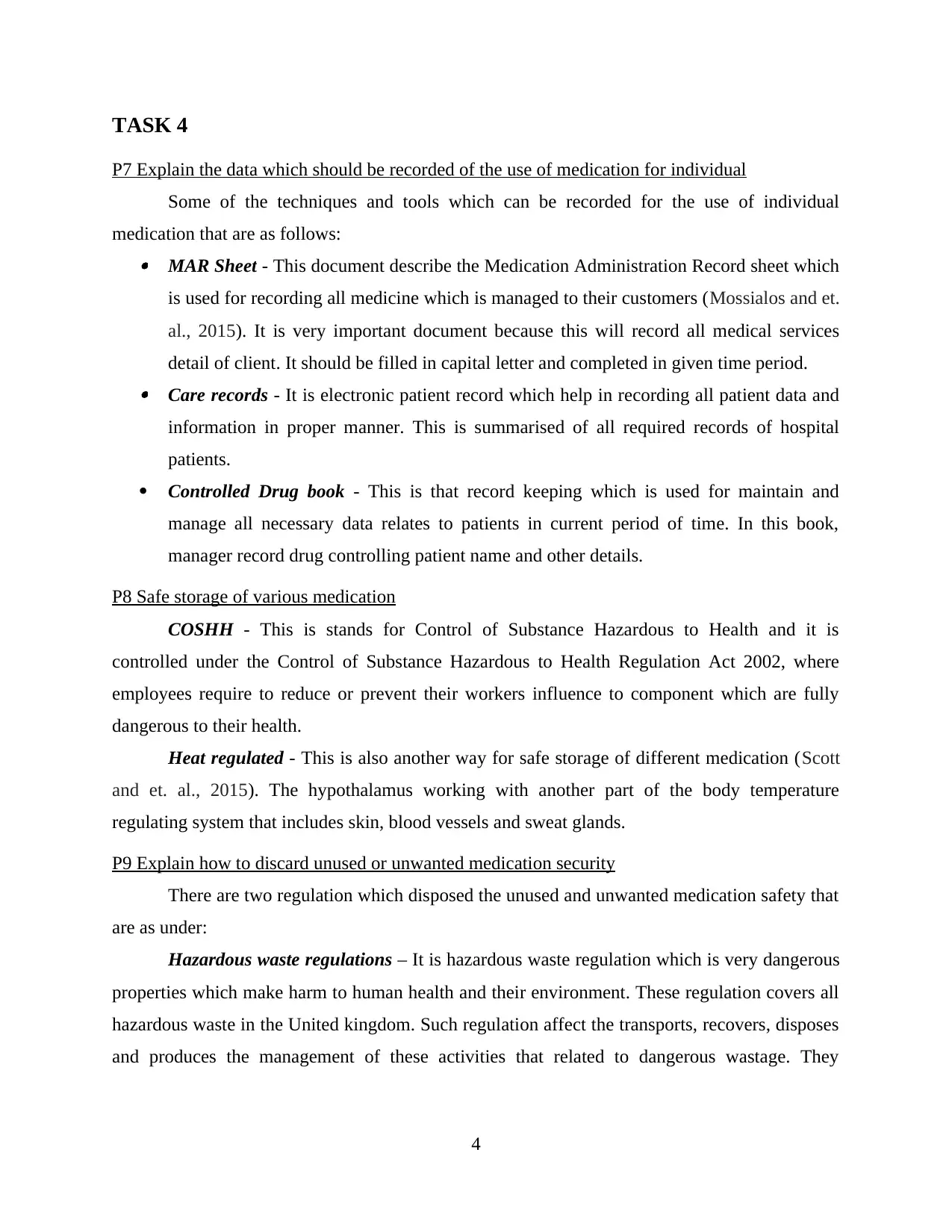
TASK 4
P7 Explain the data which should be recorded of the use of medication for individual
Some of the techniques and tools which can be recorded for the use of individual
medication that are as follows: MAR Sheet - This document describe the Medication Administration Record sheet which
is used for recording all medicine which is managed to their customers (Mossialos and et.
al., 2015). It is very important document because this will record all medical services
detail of client. It should be filled in capital letter and completed in given time period. Care records - It is electronic patient record which help in recording all patient data and
information in proper manner. This is summarised of all required records of hospital
patients.
Controlled Drug book - This is that record keeping which is used for maintain and
manage all necessary data relates to patients in current period of time. In this book,
manager record drug controlling patient name and other details.
P8 Safe storage of various medication
COSHH - This is stands for Control of Substance Hazardous to Health and it is
controlled under the Control of Substance Hazardous to Health Regulation Act 2002, where
employees require to reduce or prevent their workers influence to component which are fully
dangerous to their health.
Heat regulated - This is also another way for safe storage of different medication (Scott
and et. al., 2015). The hypothalamus working with another part of the body temperature
regulating system that includes skin, blood vessels and sweat glands.
P9 Explain how to discard unused or unwanted medication security
There are two regulation which disposed the unused and unwanted medication safety that
are as under:
Hazardous waste regulations – It is hazardous waste regulation which is very dangerous
properties which make harm to human health and their environment. These regulation covers all
hazardous waste in the United kingdom. Such regulation affect the transports, recovers, disposes
and produces the management of these activities that related to dangerous wastage. They
4
P7 Explain the data which should be recorded of the use of medication for individual
Some of the techniques and tools which can be recorded for the use of individual
medication that are as follows: MAR Sheet - This document describe the Medication Administration Record sheet which
is used for recording all medicine which is managed to their customers (Mossialos and et.
al., 2015). It is very important document because this will record all medical services
detail of client. It should be filled in capital letter and completed in given time period. Care records - It is electronic patient record which help in recording all patient data and
information in proper manner. This is summarised of all required records of hospital
patients.
Controlled Drug book - This is that record keeping which is used for maintain and
manage all necessary data relates to patients in current period of time. In this book,
manager record drug controlling patient name and other details.
P8 Safe storage of various medication
COSHH - This is stands for Control of Substance Hazardous to Health and it is
controlled under the Control of Substance Hazardous to Health Regulation Act 2002, where
employees require to reduce or prevent their workers influence to component which are fully
dangerous to their health.
Heat regulated - This is also another way for safe storage of different medication (Scott
and et. al., 2015). The hypothalamus working with another part of the body temperature
regulating system that includes skin, blood vessels and sweat glands.
P9 Explain how to discard unused or unwanted medication security
There are two regulation which disposed the unused and unwanted medication safety that
are as under:
Hazardous waste regulations – It is hazardous waste regulation which is very dangerous
properties which make harm to human health and their environment. These regulation covers all
hazardous waste in the United kingdom. Such regulation affect the transports, recovers, disposes
and produces the management of these activities that related to dangerous wastage. They
4
Paraphrase This Document
Need a fresh take? Get an instant paraphrase of this document with our AI Paraphraser
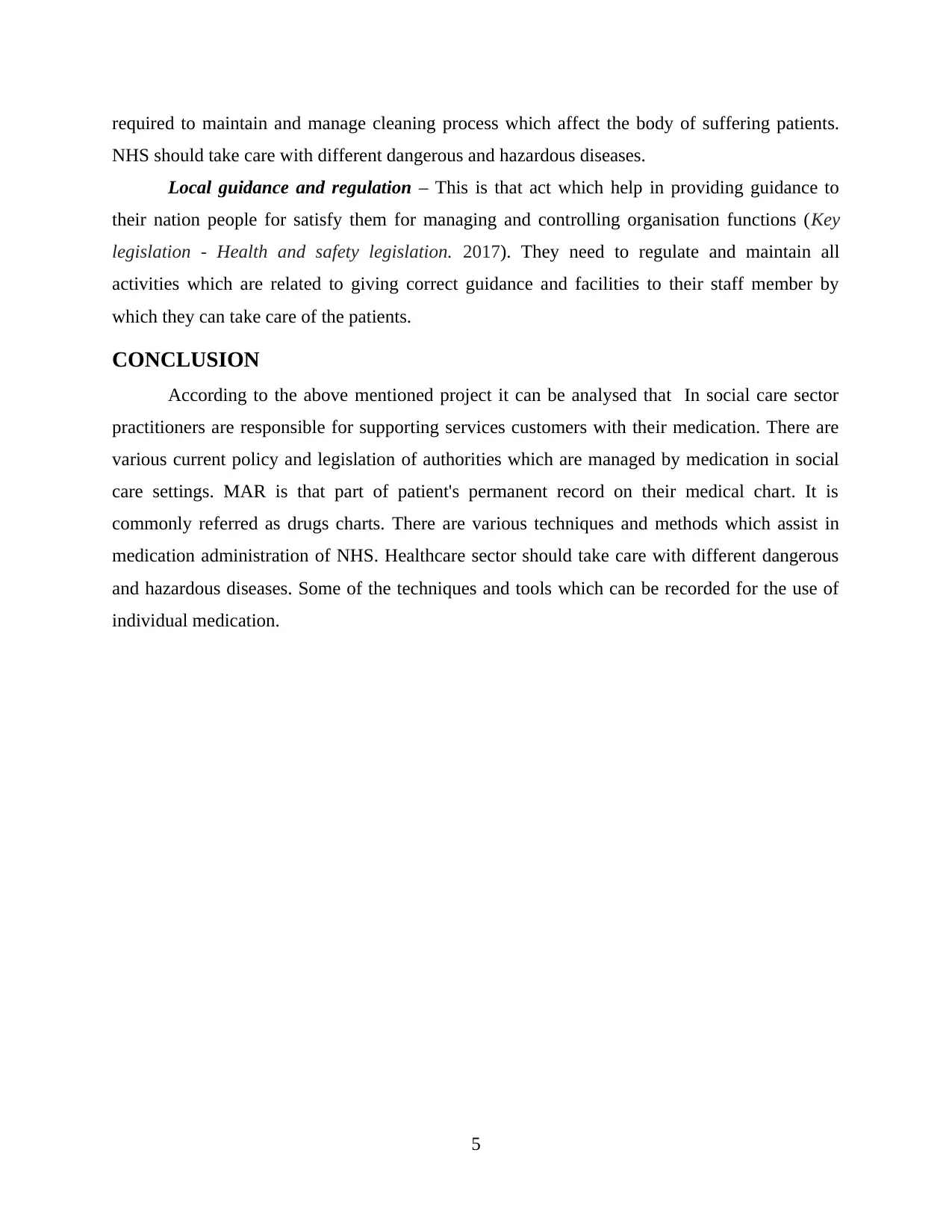
required to maintain and manage cleaning process which affect the body of suffering patients.
NHS should take care with different dangerous and hazardous diseases.
Local guidance and regulation – This is that act which help in providing guidance to
their nation people for satisfy them for managing and controlling organisation functions (Key
legislation - Health and safety legislation. 2017). They need to regulate and maintain all
activities which are related to giving correct guidance and facilities to their staff member by
which they can take care of the patients.
CONCLUSION
According to the above mentioned project it can be analysed that In social care sector
practitioners are responsible for supporting services customers with their medication. There are
various current policy and legislation of authorities which are managed by medication in social
care settings. MAR is that part of patient's permanent record on their medical chart. It is
commonly referred as drugs charts. There are various techniques and methods which assist in
medication administration of NHS. Healthcare sector should take care with different dangerous
and hazardous diseases. Some of the techniques and tools which can be recorded for the use of
individual medication.
5
NHS should take care with different dangerous and hazardous diseases.
Local guidance and regulation – This is that act which help in providing guidance to
their nation people for satisfy them for managing and controlling organisation functions (Key
legislation - Health and safety legislation. 2017). They need to regulate and maintain all
activities which are related to giving correct guidance and facilities to their staff member by
which they can take care of the patients.
CONCLUSION
According to the above mentioned project it can be analysed that In social care sector
practitioners are responsible for supporting services customers with their medication. There are
various current policy and legislation of authorities which are managed by medication in social
care settings. MAR is that part of patient's permanent record on their medical chart. It is
commonly referred as drugs charts. There are various techniques and methods which assist in
medication administration of NHS. Healthcare sector should take care with different dangerous
and hazardous diseases. Some of the techniques and tools which can be recorded for the use of
individual medication.
5
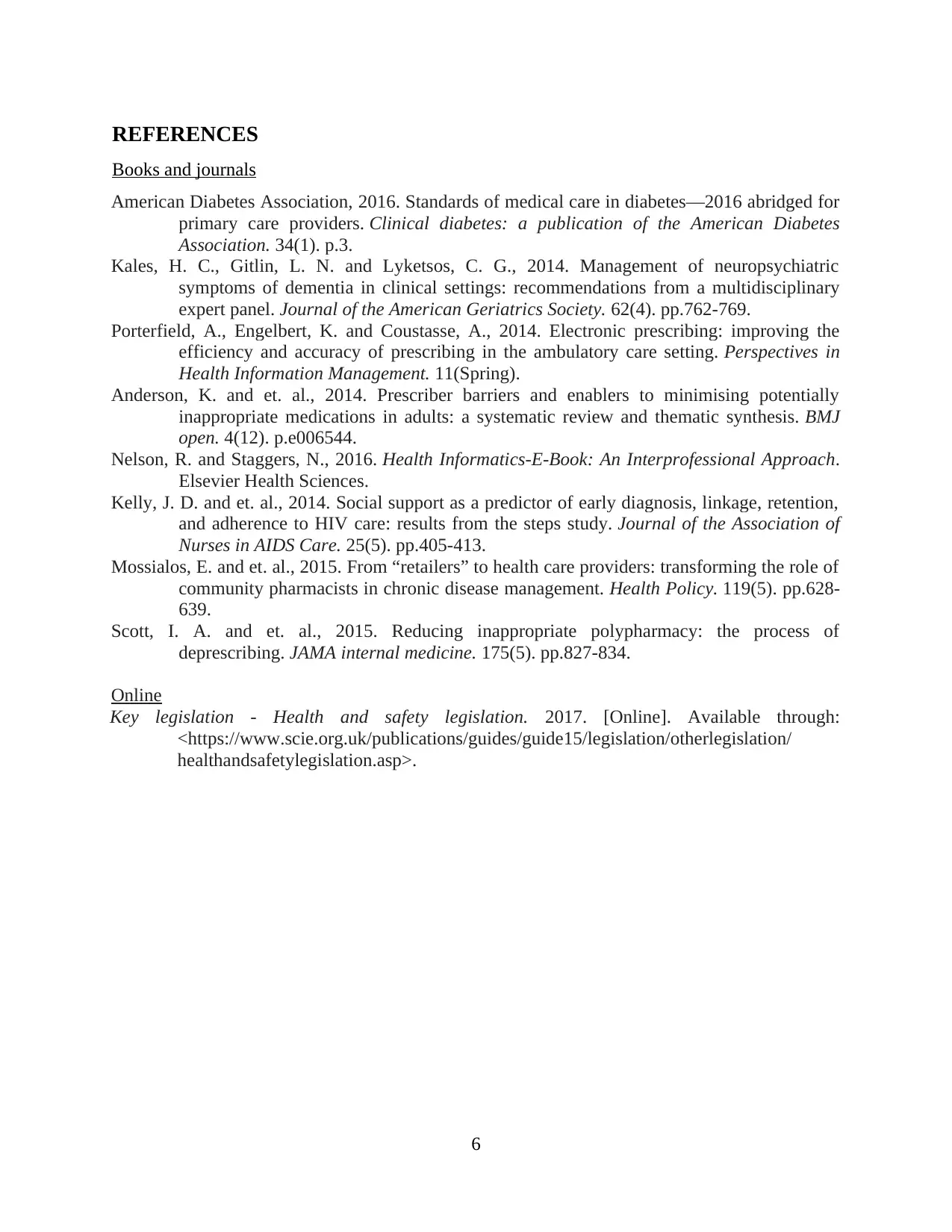
REFERENCES
Books and journals
American Diabetes Association, 2016. Standards of medical care in diabetes—2016 abridged for
primary care providers. Clinical diabetes: a publication of the American Diabetes
Association. 34(1). p.3.
Kales, H. C., Gitlin, L. N. and Lyketsos, C. G., 2014. Management of neuropsychiatric
symptoms of dementia in clinical settings: recommendations from a multidisciplinary
expert panel. Journal of the American Geriatrics Society. 62(4). pp.762-769.
Porterfield, A., Engelbert, K. and Coustasse, A., 2014. Electronic prescribing: improving the
efficiency and accuracy of prescribing in the ambulatory care setting. Perspectives in
Health Information Management. 11(Spring).
Anderson, K. and et. al., 2014. Prescriber barriers and enablers to minimising potentially
inappropriate medications in adults: a systematic review and thematic synthesis. BMJ
open. 4(12). p.e006544.
Nelson, R. and Staggers, N., 2016. Health Informatics-E-Book: An Interprofessional Approach.
Elsevier Health Sciences.
Kelly, J. D. and et. al., 2014. Social support as a predictor of early diagnosis, linkage, retention,
and adherence to HIV care: results from the steps study. Journal of the Association of
Nurses in AIDS Care. 25(5). pp.405-413.
Mossialos, E. and et. al., 2015. From “retailers” to health care providers: transforming the role of
community pharmacists in chronic disease management. Health Policy. 119(5). pp.628-
639.
Scott, I. A. and et. al., 2015. Reducing inappropriate polypharmacy: the process of
deprescribing. JAMA internal medicine. 175(5). pp.827-834.
Online
Key legislation - Health and safety legislation. 2017. [Online]. Available through:
<https://www.scie.org.uk/publications/guides/guide15/legislation/otherlegislation/
healthandsafetylegislation.asp>.
6
Books and journals
American Diabetes Association, 2016. Standards of medical care in diabetes—2016 abridged for
primary care providers. Clinical diabetes: a publication of the American Diabetes
Association. 34(1). p.3.
Kales, H. C., Gitlin, L. N. and Lyketsos, C. G., 2014. Management of neuropsychiatric
symptoms of dementia in clinical settings: recommendations from a multidisciplinary
expert panel. Journal of the American Geriatrics Society. 62(4). pp.762-769.
Porterfield, A., Engelbert, K. and Coustasse, A., 2014. Electronic prescribing: improving the
efficiency and accuracy of prescribing in the ambulatory care setting. Perspectives in
Health Information Management. 11(Spring).
Anderson, K. and et. al., 2014. Prescriber barriers and enablers to minimising potentially
inappropriate medications in adults: a systematic review and thematic synthesis. BMJ
open. 4(12). p.e006544.
Nelson, R. and Staggers, N., 2016. Health Informatics-E-Book: An Interprofessional Approach.
Elsevier Health Sciences.
Kelly, J. D. and et. al., 2014. Social support as a predictor of early diagnosis, linkage, retention,
and adherence to HIV care: results from the steps study. Journal of the Association of
Nurses in AIDS Care. 25(5). pp.405-413.
Mossialos, E. and et. al., 2015. From “retailers” to health care providers: transforming the role of
community pharmacists in chronic disease management. Health Policy. 119(5). pp.628-
639.
Scott, I. A. and et. al., 2015. Reducing inappropriate polypharmacy: the process of
deprescribing. JAMA internal medicine. 175(5). pp.827-834.
Online
Key legislation - Health and safety legislation. 2017. [Online]. Available through:
<https://www.scie.org.uk/publications/guides/guide15/legislation/otherlegislation/
healthandsafetylegislation.asp>.
6
⊘ This is a preview!⊘
Do you want full access?
Subscribe today to unlock all pages.

Trusted by 1+ million students worldwide
1 out of 9
Related Documents
Your All-in-One AI-Powered Toolkit for Academic Success.
+13062052269
info@desklib.com
Available 24*7 on WhatsApp / Email
![[object Object]](/_next/static/media/star-bottom.7253800d.svg)
Unlock your academic potential
Copyright © 2020–2025 A2Z Services. All Rights Reserved. Developed and managed by ZUCOL.





